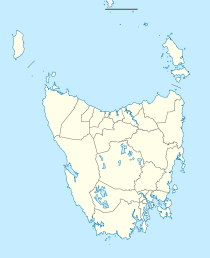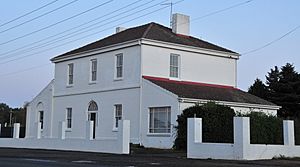Exton, Tasmania facts for kids
Quick facts for kids ExtonTasmania |
|||||||||||||||
|---|---|---|---|---|---|---|---|---|---|---|---|---|---|---|---|
| Population | 154 (2016 census) | ||||||||||||||
| Postcode(s) | 7303 | ||||||||||||||
| Location | 10 km (6 mi) W of Westbury | ||||||||||||||
| LGA(s) | Meander Valley | ||||||||||||||
| Region | Launceston | ||||||||||||||
| State electorate(s) | Lyons | ||||||||||||||
| Federal Division(s) | Lyons | ||||||||||||||
|
|||||||||||||||
Exton is a small country area in Tasmania, Australia. It's part of the Meander Valley region. You can find Exton about 10 kilometers west of Westbury. It's also close to Deloraine and sits near the railway line that connects Launceston to Devonport. In 2016, about 154 people lived in Exton.
Contents
History of Exton
Exton was first known as Marsh Paddocks. An old inn called the Marsh Paddock Inn was built around 1850. It was owned by William Walter Motton, who ran a stage coach business. This business carried people between Launceston and Westbury in the 1840s.
From 1860 to 1864, a man named George Axtell ran the inn. He was once a young convict at Port Arthur. The inn stopped serving drinks in 1920. The building was changed in the 1960s, and its top floor was removed. Today, it is a private home.
How Exton Got Its Name
Reverend Samuel Martin came to Tasmania in 1833 with his wife, Sarah Martin. Her maiden name was Exton. Reverend Martin bought a property called "Abbey Lara" and renamed it Exton. He did this to honor his wife.
He built Exton House in 1845. He also raised cattle on his large estate. The first Exton House was a single-story building. It was replaced by a two-story house in the 1850s. Around this time, the area's name changed from Marsh Paddocks to Exton.
The house was sold to William Hart in 1886. His family owned it until 1924. In the 1930s, the Exton Estate was very large, covering about 4,000 hectares. Many parts of it were rented out to other farmers. The two-story Exton House was known for having 20 rooms.
Growth and Changes
A Methodist chapel was built in 1856. By 1863, Exton had 110 people living there. It also had two hotels, a flour mill, a brewery, and a public school. That same year, Exton became part of the Westbury Municipality.
Railway transport began on February 10, 1871. This was when the western railway line opened, connecting Launceston to Deloraine. A state school and a teacher's house were built in 1890. The school cost 247 Australian pounds. It closed in 1951, and the building burned down in 1985.
By the 1930s, Exton's population went down. This happened because new machines helped with farming. Also, better transport meant fewer workers were needed. Even so, the town had more services. It had the state school, a railway station, a savings bank, and a general store. There were also offices for postal, telegraph, and money order services.
The Anglican Church started building Christ Church in 1901. It was officially opened in 1902. The church was used until the late 1970s but closed by 1991.
Sport in Exton
Exton has a very old cricket club. It played its first game in 1895. This makes it one of the oldest cricket clubs in Tasmania. A famous Australian test cricketer, Jack Badcock, was born in Exton.
Exton was officially recognized as a "locality" in 1968.
Geography
The Meander River flows through Exton. It starts in the west and flows towards the east. For a short distance, it also forms part of Exton's eastern border.
Roads in Exton
The main road, the Bass Highway (National Route 1), goes through Exton. It enters from the east and leaves towards the west. Another road, Route B54 (Meander Valley Road), also passes through Exton from east to west. Route C502 (Exton Road) starts from Route B54 and goes south out of the area.



